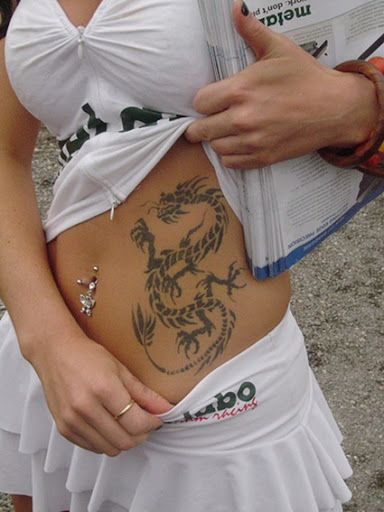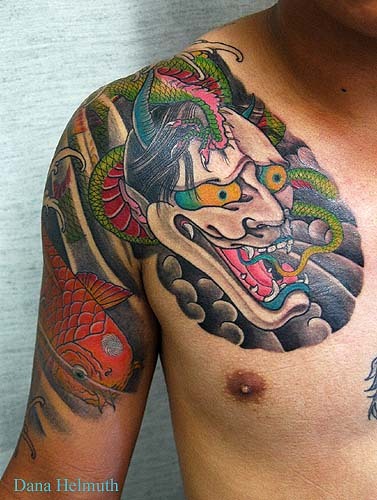Cherry Blossom Tattoos
For the Japanese the cherry blossom is seen to represent life itself. The flower is a thing of great beauty. It is strong in that is pushes itself and blooms in harsh conditions and climates and often comes out when the snow is first melting. Yet it is paradoxically fragile at the same time. It is fragile because it will only last a few days and then it will fall from the tree and land in the snow. The Japanese view this as a representation of life itself. Life should be lived to extreme beauty and everyday should be lived to it's fullest. Yet one must always be aware of the possibility of death and therefore with the eventuality of death live life even more fully. This is a great tattoo and a symbol that is laden with powerful reminders and a great guide to how each individual should live their life. Koi Fish Tattoos
Koi fish are probably the second most powerful symbol in tattoo designs in general but also fro the Japanese. Koi fish can been seen in front of almost every temple throughout Japan. The myth states that the Koi fish swim back up stream against the current to eventually read a bridge or a gate. If they can make it to the gate they are turned into dragons and magically fly away to start a new life. The symbolism behind this design is one of perseverance which is a very deep and important concept for the Japanese. In fact they have many more words to describe perseverance, effort and sticking with something in the language then we do in English. Hannya Masks
Hannya masks are scary looking and demonic masks. The mask comes from the famous Kabuki plays in Japan and it depicts a women who has been consumed with rage over a lover or someone that has not returned her love. There are different variations as each Kabuki play has a different interpretation. At any rate these masks represent a jealous women. However, they have been widely used in Japanese tattoos and also here in the west. When they are used in tattoo in it is believed that they will ward of evil spirits and bring good luck to the person wearing it. Japanese will also sometimes but these up for display high in the room of their house to ward off evil spirits. Samurai
Samurai of course lived by the code of Bushido. There is not enough room here to full explain the code of Bushido but it deals with living life to the fullest, being prepared to die in service and being loyal and strong. The concepts of Bushido are pretty much at the heart of all Japanese values and morals and also what is taught to most young kids over and over again through stories. You could say the code of Bushido is the heart of the Japanese culture and beliefs. Samurai's and samurai tattoos of course are the best symbol of these beliefs.These are just four of the most popular themes within Japanese tattoos. One of these might be right for your design and what you are looking for. There are tons of other Japanese tattoo meanings and tattoo design out there. It is best to do some reaserch and spend time finding a design that is right for. This site dedicated to Tattoo Designs can be very helpful in finding the design that is right for you. Check out this site if you want to learn more about other tattoo meanings [http://www.mycustomtattoo.com/blog] and tattoos in general
Article Source:Chris_Ryerson








































